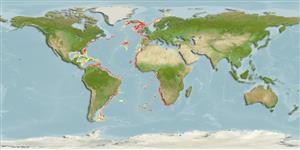Common names from other countries
Classification / Names / Names
Namen | Synonyme | Catalog of Fishes (gen., sp.) | ITIS | CoL | WoRMS
Environment: milieu / climate zone / depth range / distribution range
Ökologie
; tiefenbereich 400 - 1230 m (Ref. 97531). Tropical
Eastern Atlantic: from southwest Sahara to Namibia.
Length at first maturity / Size / Gewicht / Alter
Maturity: Lm ? range ? - ? cm Max length : 16.7 cm TL Männchen/unbestimmt; (Ref. 434)
Benthic or benthopelagic (Ref. 97531). Inhabits waters over muddy sand bottoms of the continental slope at depths from 500 to 1100 m. Carnivorous (Ref. 434).
Life cycle and mating behavior
Geschlechtsreife | Fortpflanzung | Ablaichen | Eier | Fecundity | Larven
Members of the order Decapoda are mostly gonochoric. Mating behavior: Precopulatory courtship ritual is common (through olfactory and tactile cues); usually indirect sperm transfer.
Fischer, W., G. Bianchi and W.B. Scott (eds.). 1981. (Ref. 434)
IUCN Rote Liste Status (Ref. 130435)
CITES Status (Ref. 108899)
Not Evaluated
Not Evaluated
Nutzung durch Menschen
| FishSource |
Tools
Mehr Information
Alter/GrößeWachstumLänge-GewichtLänge-LängeMorphologieLarvenDichte
Internet Quellen
Estimates based on models
Preferred temperature
(Ref.
115969): 4.3 - 7.3, mean 5.8 (based on 34 cells).
Verwundbarkeit
Low vulnerability (10 of 100).
Preiskategorie
Unknown.
